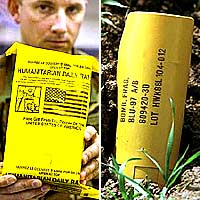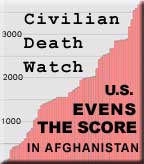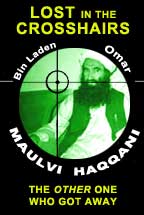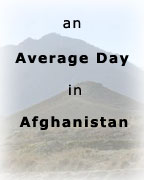Above the Law and Below Morality: Data on 11 Weeks of U.S. Cluster-Bombing of Afghanistan
['shining like a diamond,' death comes in a little yellow soda can]
Professor Marc W. Herold
Ph.D., M.B.A., B.Sc.
"SOME OF the most savage weapons of modern warfare." That’s how one BBC journalist described cluster bombs, the U.S. military’s latest weapon of choice in Afghanistan. It's also deadly and cheap.

POSTED FEBRUARY 1, 2002 --
On October 10th, 2001, U.S. B-52s and B-1s began dropping deadly 1,000 lb. CBU-87 [$14,000 a bomb] and the wind-corrected CBU-103 cluster [fragmentation] bombs upon "soft targets" [vehicles and people] in Afghanistan.
Eleven weeks later, U.S.planes had dropped 1,210 cluster bombs, each containing 202 BLU-97 bomblets. The British Halo Trust now estimates on the basis of groundwork in the vales of Afghanistan that 20% of the bomblets failed to explode, meaning 48,884 yellow soda-can sized, yellow-colored deadly sub-munitions now litter the villages, paths and fields of Afghanistan.
During the Kosovo air campaign, U.S. and allied planes dropped 1,392 cluster bombs, with a reported fail rate of 8-12%. In the Gulf War, Allied forces dropped 62,000 air-delivered cluster bombs. The British group, Landmine Action, says that over 13 million bomblets were used in the 1991 Gulf War and 1.2 million explosive duds cover Iraq and Kuwait. Pentagon estimates suggest some 285 million such sub-munitions were dropped on Cambodia, Vietnam, and Laos.
A favorite U.S. weapon used in Afghanistan has been the 1,000 lb CBU-87 cluster bomb with its 202 BLU-97 bomblets. The BLU-97 cluster bomblet is one of the cheapest air-delivered weapons available, costing only ~$60 per unit. Unlike most American mines, cluster bomblets are not designed to break down over time as this would raise their low cost.3A single BLU-97 bomblet kills anyone within a 50 meter radius and severely injures a person within 100 meters. It is considered more dangerous than a conventional land mine. Peter Le Sueur, technical adviser to the UN's Mine Action Program Afghanistan [MAPA] describes this weapon,
"the BLU 97 had three purposes -- to destroy armoured vehicles, kill people with shrapnel fragments and ignite fires in military targets such as munition dumps or oil depots."
According to Le Sueur, one of its most savage features is its six-millimetre diamond-patterned steel jacket. "When the bomb explodes, the steel splits so you get hundreds of high-velocity steel fragments travelling at the speed of a rifle bullet. "They can kill or injure people from over 100 metres (330 feet) from the point of detonation".3
On New Year's Day, 2002, the United Nations' UNIC Director Eric Falt disclosed that U.S. planes had dropped cluster bombs in 103 cities of Afghanistan and possibly in another 25.5 The areas around Herat, the Shomali Plain and Tora Bora were particularly hard hit with cluster bombs. More than 600 cluster-bombs were dropped by U.S. planes in the Shomali plain region alone during the five weeks the U.S. planes pounded Taliban positions.6
The villages of Denar Kheil, Kalakhan and Qarabagh were particularly hard hit, being covered by BLU-97s. Early on November 10, 2001, CBU-87 bombs were dropped upon Denar Kheil in the Shomali Plain. Between January 9 - 20th , a de-mining team found 100 active BLU-97 bomblets in the village.7 It is believed that snow, sand and mud in Afghanistan make it even more likely that the bomblets are not exploding [hence the higher reported dud rate].
The CBU-87, 1,000 lb. bomb was developed by the Aerojet General Corporation in 1983 [entering service in 1986 replacing Vietnam era cluster bombs] which produced it along with the Alliant Techsystems Inc. [Hopkins, Minnesota]. Today, the CBU-87s are assembled in an Army factory in southern Kansas, from parts supplied by Honeywell [Minnesota] and Aerojet [Sacramento, California].
The 'mother bomb' carries 202 bright yellow bomblets, each the size of a soda can (see photo). The mother bomb explodes about 300-400 feet above earth and the 202 bomblets are dispersed with little parachutes. They are supposed to explode upon landing, but at least 5% do not.  The CBU-87's 'footprint' is about 400x800 meters. Each bomblet, in turn, fragments into 300 steel fragments, making for a total of 60,600 fragments per CBU-87 bomb. One CBU-87 spreads bomblets over about three football fields. One B1-B 'Lancer' bomber can carry 30 CBU-87 bombs.8 A B-52 carries 40 CBU-87s, with a total hence of 8,080 BLU-97 cluster bomblets!
The CBU-87's 'footprint' is about 400x800 meters. Each bomblet, in turn, fragments into 300 steel fragments, making for a total of 60,600 fragments per CBU-87 bomb. One CBU-87 spreads bomblets over about three football fields. One B1-B 'Lancer' bomber can carry 30 CBU-87 bombs.8 A B-52 carries 40 CBU-87s, with a total hence of 8,080 BLU-97 cluster bomblets!
Cluster bombs are anti-vehicle and anti-personnel weapons. They kill people without destroying property. They also serve as land mines and detonate later, even years later, when they are unearthed. The Times noted that the U.S. lobbied at a landmine conference some years ago against classifying cluster bombs as landmines.9 But they serve this secondary and murderous purpose: "35,000 unexploded bomblets in Kosovo still kill one person a week," the paper noted. They are still killing people in Laos, 30 years after the war there ended: 30 years after being dropped from U.S. planes, one Laotian a month dies of a cluster bomblet.10
Nazeer Ahmad, de-miner for the Organization for Mine Clearance and Afghan Rehabilitation [OMAR] based in Jalalabad, says,
"We completely forgot about the Russian bombs and mines when we saw American cluster bombs. They are horrible things. Nobody knows how to detect them and nobody knows how to destroy them. In Herat when Americans dropped cluster bombs, there were little bomblets that were yellow color. Children thought they might be food. Thirty have been killed and 25 wounded by cluster bombs."11
Suzanne Goldenberg reports from Herat that at least 41 persons have been killed and 46 injured by cluster bombs in the area since the bombing ceased.12 Farnaz Fassihi reported for the Newhouse News Service in late December how "at the Wazir Akbar Khan Hospital in Kabul, all the beds in the children's ward are occupied by youngsters injured by cluster bomblets."13
As Mark Baker writes, the terror began just after midnight on October 22nd in Shaker Qala when villagers were awakened from their sleep by the sound of aircraft . Moments later bombs were raining down. Two hours later, eight people had perished, dozens were wounded. Villagers scrambled from their homes, putting the wounded on carts to take them to Herat's hospital four kilometers away. A new danger lurked in the guise of yellow soda cans scattered through the village's narrow lanes and adjacent fields.
The first victim of an unexploded cluster bomb was blown up in Shakar Qala, outside Herat:
"The UN confirmed that eight people had been killed immediately in the attack on Shakar Qala, and a ninth had died after picking up the parachutes attached to the bombs."
“He went to look at the object, touched it and it blew up,” Stephanie Bunker, a spokeswoman, said. Fourteen others were injured and 20 of the village’s 45 houses were destroyed or badly damaged.."15
The attack upon Shakar Qala reportedly scattered 200 pieces of unexploded ordnance across the village.
On Wednesday, November 21st, twelve-year old Mohibollah was out collecting firewood in a shabby neighborhood on the edge of Herat. Minutes later, he was running down the street screaming, his face splattered with blood. A stump of flesh, smashed bones and mangled fingers dangled from his left arm. He was a victim of the legacy of a Monday night bombing attack on October 22nd, when U.S. planes dropped cluster bombs upon the village of Qali-e-Shater [Shakar Qala], two miles northeast of Herat.
The attack itself killed eight immediately with a ninth dying from an unexploded bomblet the next day. The U.S. attack also destroyed 30 of the hamlet's 45 homes. The intended target was a Taliban base two kilometers away. A resident, Abodolahad, recounted how eight bomblets landed on his house, peppering the walls with shrapnel and killing his brother. But four of the bomblets failed to explode, forcing the family out to live with neighbors. Another recent report describes the cluster-bombing of Qala Shater village:
"At least six of the bomblets parachuted to earth in the narrow passageway linking the Farid family compound to the road, bursting through a mudwall and gouging out chunks of plaster from the main home. One family member died, two teen-aged neighbors were killed, and two unexploded bomblets remained behind.
At first, the family waited, and then they decided to try their luck. A friend of Ahmed Farid, 26, after trying defusing techniques, decided to hurl a bomblet into the courtyard of an abandoned home next door. Unfortunately, Ahmed was crossing the courtyard. Fiery bits of shrapnel burnt a series of almond-sized scars from right shoulder to calf, and put the iron worker in the hospital for two days…"17
Since the bombing, 12 more civilians have died. Rains in mid-January have washed cluster bomblets downstream. And more than a month later, the United Nations Mine Action local staff reported completing the destruction of cluster bombs in 54 homes and a mosque in the village of Qali-e-Shater.18
On December 7th, in Sakhsalmun, a village about four kilometers outside Herat, it was a family's visit to a relative's home.19 The kids didn't want to stay inside listening to grown-up talk and raced outside. Abdul Nasir, 14, and others scrambled up the hillside next to the hamlet. They came across the little yellow soda can with a parachute attached to it. One boy picked it up and it went off. His body was shredded. Abdul Nasir was comparatively lucky: his jaw was badly broken and one of his hands sliced between his two middle fingers. In early December, he sat in the surgical ward at the Herat Red Cross Hospital. U.S. planes had cluster-bombed Sakhsalmun earlier, close to a former Taliban garrison, and four civilians had been killed by U.S. bombs which missed their target.
According to official data of the local de-mining organizations and the regional hospital in Herat, 38 deaths and an unknown number of injured people due to cluster bombs have been registered. However, some doctors at the Herat regional hospital in January 2002, believe this number is much higher. In the village of Qala Shakar near Herat city alone, 12 people died and more than 20 were injured due to cluster bombs.20 In the village of Rabat, 1/2 hour west of Herat, 10 civilians have died since U.S. bombing ceased in early November.
|
More than 10 Afghans are killed or injured each day from unexploded ordnance. And nearly one out of 10 families has a member who has been disabled by mines or other unexploded ordnance. The situation is magnified insofar as the location of such unexploded munitions:
"At present, almost half of the 725 square kilometers of land identified as minefields is concentrated in the urban areas where Afghans live, or in the small percentage of Afghanistan's fertile land where Afghans raise crops or livestock."31
A case in point is the village of Shaker Qala, where for many days villagers remained cloistered inside their homes fearing to emerge because of cluster bombs scattered through the entire village. Farmers returning to regions around Herat and in the once fertile Shomali plain [wheat and orchards] have been particularly vulnerable to unexploded cluster bomblets.
Widely decried by over 50 humanitarian and medical groups across the world, the U.S. defends its use of cluster bombs as an appropriate response to the killings at the World Trade Center. The French Nobel-prize [1999] winning organization, Doctors Without Borders, finds cluster bombs being indiscriminate weapons and based upon the provisions in the Geneva Protocol their use is thus prohibited [Additional Protocol I, Art. 51, 4 and 5b]. The International Red Cross called for an international ban on cluster bombs in September 2000.33
The casing of a CBU-87 bomb found in Tora Bora had a hand-stenciled note on it, "this is gonna shine like a diamond in a goat's ass - Gary."34
Is the United States above international humanitarian law and below the standards of international morality?

Source: Jonathan Marcus, "Analysis: Why Use Cluster Bombs?" BBC News Online [August 2, 2000].
Footnotes
1 data from United Nations Mine Action Programme in Afghanistan, reported in Naveed Ahmad, "Coalition Provides Information About Sub-Munitions in Struck Areas," Daily Jang [December 22, 2001], also reported in Asia Times [January 3, 2002]. See also the report by Human Rights Watch, "Cluster Bombs Litter Afghanistan" [New York: Human Rights Watch, November 16, 2001] and Naveed Ahmad, "UN to Clear 103 Afghan Cities of Cluster Bombs," Daily Jang [January 2, 2002].
2 Scott Canon, "Leftover Bomblets Leave Big Questions. Are Cluster Bombs Necessary or Unethical?" Pittsburgh Post-Gazette [November 4, 2001]: A12.
3 "Taliban Appeal Against US' Use of Cluster Bombs," Hindustan Times [October 26, 2001].
4 from Mike Williams, "Bomb Damage at Tora Bora Shows Ferocity of U.S.Response," Cox News [December 12, 2001].
5 "Cluster Bombs Dropped in 103 Afghan Cities," Paknews.com January 1, 2002.
6 Carol J. Williams, "Work to Root Out a Buried Foe Gains Urgency in Afghanistan," Los Angeles Times [December 24, 2001].
7 Elizabeth Neuffer, "Fighting Terror After the Battle. Unexploded Bomblets Mine Villages," Boston Globe [January 20, 2002]: A23.
8 www.fas.org/man/dod-101/sys/dumb/cbu-87.htm ; and "Members Fight for Guns and Butter," Washington Post [May 1, 1990]; and Paul Watson and Lisa Getter, "Silent Peril Lies in Wait for Afghanistan's People," Los Angeles Times [December 1, 2001].
9 Simon Jenkins, "Cluster Bombs: These Are Land Mines by Any Other Name," The Times [October 26, 2001]. On Laos, see Matt Warren, "Afghanistan Set to Share Legacy of Death That Cluster-Bombing Left in Indochina," The Scotsman [November 5, 2001], at : www.zmag.org/warrencluster.htm . See also Titus Peachey and Virgil Wiebe, "Appendix 1: Laos. The Air War" [Mennonite Central Committee, November 2000], at www.mcc.org/clusterbomb/report/laos_appendix.html
10 from Heather Cottin, "What Kind of War is This? A Murder of Innocents and a Plunder of Resources" {New York: International Action Center, no date].
11 Scott Baldauf, "Help for Survivors of Afghanistan's Land Mines," Christian Science Monitor [January 4, 2002]
12 Suzanne Goldenberg, "Long After the Air Raids, Bomblets Bring More Death," The Guardian [January 28, 2002].
13 Farnaz Fassihi, "At Every Step on Afghan Soil, Death Lurks Underneath," Newhouse Newsw Serevice [December 28, 2001].
14 Mark Baker, "If the Cluster Bombs Don't Get You, the Mines Might," Sydney Morning Herald [October 26, 2001].
15 from Landmine Action News, "Cluster Bombs Are New Dangers toMine Clearers," [October 26, 2001].
16 Jon Hemming, Reuters, "Unexploded Cluster Bomb Maims Afghan Boy," The Hindustan Times [November 21, 2001].
17 Goldenberg,op. cit.
18 "Landmine Kills 2 Children in Heart: UN," Dawn [November 30, 2001].
19 from Hamish McDonald, "Death Comes in a Little Yellow Package," Sydney Morning Herald [December 17, 2001].
20 Medecins Sans Frontieres, "Cluster Bombs the Legacy to Afghan Population," Relief Web [January 18, 2002]
21 "Air Strikes Continue, U.S.TakesOer Airaves," Times of India [October 31, 2001].
22 UN Integrated Regional Information Network, "Afghanistan: Focus on the Risk of Unexploded Ordnance," November 7, 2001.
23 The after-effects of cluster-bombing are well-captured in C.J. Chiers, "An Afghan Village Where Errant Bombs Fell and Killed, and Still Lurk in Wait," New York Times [December 12, 2001].
24 Jon Hemming [Reuters], "Unexploded Cluster Bomb Maims Afghan Boy," Hindustan Times [November 21, 2001].
25 P. Watson and L. Getter, "Weapons: Unexploded Bomblets' Toll on Civilians Has Renewed Controversy Over Their Use," Los Angeles Times [December 1, 2001].
26 "Three Afghan Children Die in Cluster Bomb Explosion," Out There News/AUSAF [November 27, 2001].
27 Anna Badkhen, "Unexploded Bombs Ticking for Children," San Francisco Chronicle [December 3, 2001]: A1.
28 Hamish McDonald, "The War is Over, But the Loss of Innocents Continues," The Age [December 17, 2001].
29 Goldenberg, op. cit.
30 Elizabeth Neuffer, op. cit.
31 Baldauf, op. cit.
32 Richard Beeston and Helen Rumbelow, "Allies Defend Cluster Bombs," The Times [October 29, 2001].
33 Alexander G. Higgins, "Red Cross Urges Cluster Bomb Halt," The Associated Press [September 5, 2000]. Other groups are engaged in a campaign to ban cluster bombs, see "Campaign Targets 'Lethal' Cluster Bombs," BBC News Online [December 2, 2001].
34 from Mike Williams, "Bomb Damage at Tora Bora Shows Ferocity of U.S.Response," Cox News [December 12, 2001].


